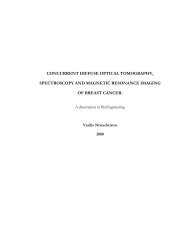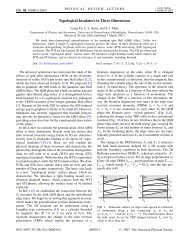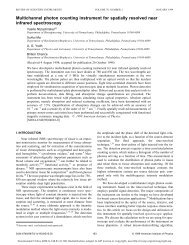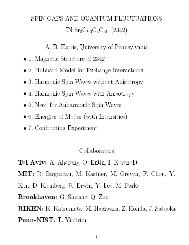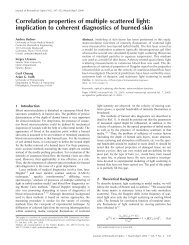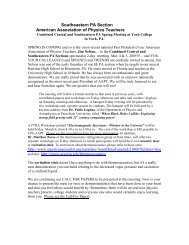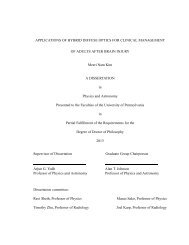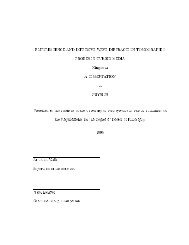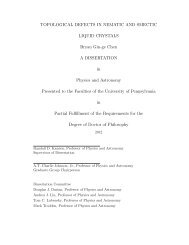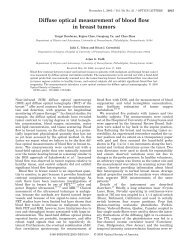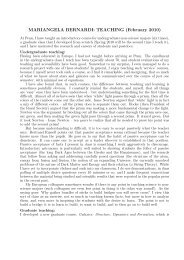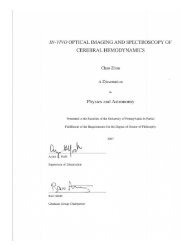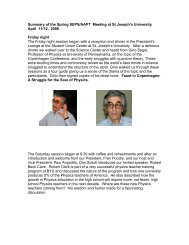- Page 1 and 2:
SHG SPECTROSCOPY OF GALLIUM NITRIDE
- Page 3 and 4:
COPYRIGHT vVilliam E. Angerer 1998
- Page 5 and 6:
ACKNOWLEDGEMENTS I am most grateful
- Page 7 and 8:
vi and support over the last three
- Page 9 and 10:
viii and we report on photoluminesc
- Page 11 and 12:
x 2.5 ~ovel Technique and Apparatus
- Page 13 and 14:
Xll 7.3 7.2.3 Registering and Posit
- Page 15 and 16:
xiv
- Page 17 and 18:
xvi 2.10 Device for measuring ultra
- Page 19 and 20:
xviii 6.5 Polarization and propagat
- Page 21 and 22:
2 scopies as a probe of these featu
- Page 23 and 24:
4 tionallinear microscopy is unable
- Page 25 and 26:
6 interference by group velocity mi
- Page 27 and 28:
Chapter 2 Introduction to Nonlinear
- Page 29 and 30:
10 the electric fields as In this t
- Page 31 and 32:
12 SHG is a virtual process, Le. th
- Page 33 and 34:
14 2.3 (2) Xijk and Symmetry In gen
- Page 35 and 36:
16 X (2) zxx = ,\.zyy v(2) (2) = v(
- Page 37 and 38:
18 X~}k(W = 2wo) of our GaN samples
- Page 39 and 40:
20 nonlinear element of quartz, X~~
- Page 41 and 42:
22 the transmitted wave, E:t'°, Th
- Page 43 and 44:
24 150 I I "1 I :) ~ >- -. iii c v
- Page 45 and 46:
26 Quartz fundamental Figure 2.5: I
- Page 47 and 48:
28 The bound wave, which propagates
- Page 49 and 50:
30 1/e 2 its ma.'{imum value. This
- Page 51 and 52:
32 Here, x~;!Aw = 2wo) is a constan
- Page 53 and 54:
34 simplifications (2.39) and (2.40
- Page 55 and 56:
36 nonlinear waves. This model assu
- Page 57 and 58:
38 Fourier transform to E /2 (r, w)
- Page 59 and 60:
40 3 mm and with the parameters dis
- Page 61 and 62:
42 I " i iii iii iii iii iii iii ii
- Page 63 and 64:
44 parameter value Bl 2.35728 B2 -0
- Page 65 and 66:
46 is measured as a function of tra
- Page 67 and 68:
48 send pulse into device \11 input
- Page 69 and 70:
50 2.6 Conclusion In this brief sec
- Page 71 and 72:
52 LOCK-IN AMPLIAER LOCK-IN AMPLIAE
- Page 73 and 74:
54 After polarization, the beam was
- Page 75 and 76:
56 PO HR !l o IV team BP Figure 3.3
- Page 77 and 78:
58 .. ........... • / ~ '" ~ r --
- Page 79 and 80:
60 The production of ultrafast, hig
- Page 81 and 82:
62 800 ~ 0 0 J 0 0 0 0 J ~ 0 600~ 0
- Page 83 and 84:
64 measurements. Typically, I incre
- Page 85 and 86:
66 described below. Note that laser
- Page 87 and 88:
68 sentiallya nonlinear optical int
- Page 89 and 90:
70 780 800 820 840 860 880 900 920
- Page 91 and 92:
72 Unlike the linear spectroscopic
- Page 93 and 94:
74 fore, the ratio of these two qua
- Page 95 and 96:
76 of :UN is deposited on the Ah03
- Page 97 and 98:
78 computer HeNe Las polarizer chop
- Page 99 and 100:
80 ~------".... GaN A12a3 index flu
- Page 101 and 102:
82 + d I , GaN A12a3 Figure 4.3: Co
- Page 103 and 104:
84 4.2 Measurement of Indices of Re
- Page 105 and 106:
86 fields at the lh interface to th
- Page 107 and 108:
88 traveling wave, i.e. (-1.7) wher
- Page 109 and 110:
90 Note that the additional subscri
- Page 111 and 112:
92 £b, are defined only at the int
- Page 113 and 114:
94 Equations (4.30) and (4.32) are
- Page 115 and 116:
96 the calculation of the transmitt
- Page 117 and 118:
98 '- -0 OJ N 0.4 o E ~ o Z 0.2 o 2
- Page 119 and 120:
100 2.0 "'"" "I 1.5 E ::t ~ --c 0 -
- Page 121 and 122:
102 4.3 Photoluminescence of GaN To
- Page 123 and 124:
104 a photoluminescence measurement
- Page 125 and 126:
106 :J 0.01 0 ~ L ~ 0.008 r- :n :v
- Page 127 and 128:
108 0.08 ~. j -i ,-... I I ""I :::l
- Page 129 and 130:
Chapter 5 Properties of GaN In rece
- Page 131 and 132:
112 5.1 Crystal Structure :\ crucia
- Page 133 and 134:
114 PJO'tI [{fall Figure 5.1: \Vurz
- Page 135 and 136:
116 e 4 r .1 It Figure 5.2: Calcula
- Page 137 and 138:
118 Parameter Symbol Value electron
- Page 139 and 140:
120 high intrinsic electron concent
- Page 141 and 142:
122 equation (5.2), is represented
- Page 143 and 144:
124 C6v E E £l. 2C3 2C 3 2C6 2C 6
- Page 145 and 146:
126 gap, the nonlinear susceptibili
- Page 147 and 148:
128 rrb 10.0 eV -------- 5 9.0 eV r
- Page 149 and 150:
130 In> 1m> 1m>
- Page 151 and 152:
132 Emission of a photon on the bra
- Page 153 and 154:
134 5.5 MOCVD Growth of GaN Our GaN
- Page 155 and 156:
136 # dopant thickness mobility car
- Page 157 and 158:
138 6.1 Nonlinear Optical Spectrosc
- Page 159 and 160:
140 y lab X)lSlaJ / 2m Figure 6.1:
- Page 161 and 162:
142 Fig. 6.2 displays the azimuthal
- Page 163 and 164:
144 includes the effects of pulse p
- Page 165 and 166:
146 6.3 Theory of Nonlinear Optical
- Page 167 and 168:
148 L x i d 1 E( 00) air GaN sapphi
- Page 169 and 170:
150 wavevector components. The free
- Page 171 and 172:
152 z y x E( ro) air GaN Figure 6.5
- Page 173 and 174:
154 various free waves and summing
- Page 175 and 176:
156 factors are: the nonlinearity o
- Page 177 and 178: 158 where v /2 is the group velocit
- Page 179 and 180: 160 i N -' '- 0 ::J a 0 o.sf fiftH!
- Page 181 and 182: 162 4 ""' ::J en Q) - -' .D 2L ·oJ
- Page 183 and 184: 164 approximation. The agreement be
- Page 185 and 186: 166 midgap state) could playa role
- Page 187 and 188: 168 r: b S ~ r b I rs ~ r b I 0)1 r
- Page 189 and 190: 170 in various bonding geometries w
- Page 191 and 192: , 172 .----. ::l U'J Q) ttl 0 '-.,;
- Page 193 and 194: Chapter 7 SHG Microscopy The majori
- Page 195 and 196: 176 7.1 Historical Context of Secon
- Page 197 and 198: 178 comPJter - - - - - - - - - ~ ,-
- Page 199 and 200: 180 second-harmonic light towards t
- Page 201 and 202: 182 ~ 20 _____ ~ ____ J -----f- ---
- Page 203 and 204: 184 wave at normal incidence is (7.
- Page 205 and 206: 186 polarization is negligible for
- Page 207 and 208: chopper AGate B Gate Signal Figure
- Page 209 and 210: 190 E 4000 1 c: 0 3000 ~ rJl -' 0 c
- Page 211 and 212: 192 depend on two components: a hig
- Page 213 and 214: 194 nanorope ~ Figure 7.8: Carbon n
- Page 215 and 216: 196 of light reflected from the sam
- Page 217 and 218: 198 mean square deviation, of the p
- Page 219 and 220: 200 7.3 Calculated SHG Signal from
- Page 221 and 222: 202 parameter symbol value laser re
- Page 223 and 224: 204 parameter symbol value surface
- Page 225 and 226: Chapter 8 Conclusion In this brief
- Page 227: 208 properties of carbon nanotubes.
- Page 231 and 232: Appendix B Theory of Nonlinear Resp
- Page 233 and 234: 214 Fourier transforming equation (
- Page 235 and 236: 216 and (CA) with f.b == t(.:.vo) a
- Page 237 and 238: 218 The polarization, et, of the po
- Page 239 and 240: 220 and (0.1.,1) respectively. Equa
- Page 241 and 242: Appendix E Effect of Sapphire Miscu
- Page 243 and 244: 224 with cosO 0 - sin (} o 1 o (E.3
- Page 245 and 246: 226 Let us compare the light transm
- Page 247 and 248: 228 , .............................
- Page 249 and 250: 230 it ( (fp·top..,(arr (ll, M r "
- Page 251 and 252: 232 nal-2.00 tab'(:r[ihi]-:r[ila] )
- Page 253 and 254: 234 1 - 2500.0; III - xU]; 1/ ti. t
- Page 255 and 256: Bibliography [1] R. K. Chang~ J. Du
- Page 257 and 258: 238 [12] J. QL "V. Angerer, M. S. Y
- Page 259 and 260: 240 Diamond, SiC and Wide Bandgap S
- Page 261 and 262: 242 [40] M. M. Choy and R. L. Byer,
- Page 263 and 264: 244 [55] \V. P. Lin, P. M. Lundquis
- Page 265 and 266: 246 [70] J. vV. Yang, J. N. Kunzia,
- Page 267 and 268: 248 [85] B. Monemar and O. Lagerste
- Page 269 and 270: 250 [99] R. C. Miller, Optical Seco
- Page 271 and 272: 252 [114] "V. de HeeL W. S. Bacsa,



